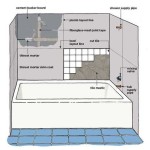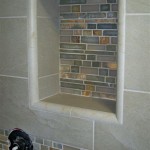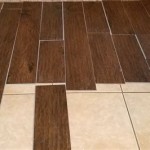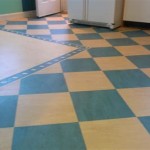Can You Lay Ceramic Tile On Concrete Floor
Ceramic tile offers a durable and aesthetically pleasing flooring option for various applications. Concrete subfloors provide a stable base for tile installations, but proper preparation and execution are essential for a successful, long-lasting result. This article examines the feasibility and process of laying ceramic tile directly onto a concrete floor.
Concrete is a generally suitable substrate for ceramic tile. Its rigidity and strength offer excellent support, preventing tile cracking and movement. However, certain conditions must be met before tile installation can begin. The concrete must be completely cured, free of significant cracks or damage, and level. Moisture is a critical concern; excessive moisture within the concrete can lead to adhesive failure and tile detachment. Therefore, assessing the concrete's moisture content is a crucial first step.
Several methods exist for testing concrete moisture levels. Relative humidity testing involves sealing a probe into the concrete and measuring the trapped air's humidity. Calcium chloride testing utilizes a weighed amount of anhydrous calcium chloride placed under a sealed dome on the concrete surface. After a specific period, the calcium chloride is re-weighed; the weight gain indicates the amount of moisture absorbed from the concrete. Another method is the polyethylene sheet test, where a plastic sheet is taped to the concrete. After a designated time, the presence of moisture under the sheet signals potential moisture problems.
Once acceptable moisture levels are confirmed, the concrete surface must be prepared. Any existing coatings, such as paint or sealant, must be removed. Mechanical methods like grinding or shot blasting are effective for removing coatings and achieving a suitable profile for adhesion. Cleaning the concrete surface is crucial. Dust, debris, and grease can interfere with the bonding of the tile adhesive. A thorough cleaning with a suitable cleaner and a stiff brush, followed by rinsing, is typically required.
Cracks or imperfections in the concrete surface need attention. Minor cracks can be filled with a patching compound specifically designed for concrete. Larger cracks or significant damage may require professional repair. Leveling the concrete surface is essential for a professional-looking tile installation. Self-leveling underlayment can be applied to address minor unevenness. For significant variations in height, a more substantial leveling compound may be necessary.
Selecting the appropriate tile adhesive or mortar is crucial. Thin-set mortar is commonly used for ceramic tile installations over concrete. Modified thin-set mortars offer improved bonding and flexibility, particularly beneficial for larger format tiles or areas subject to temperature fluctuations. The manufacturer's instructions should be followed precisely regarding mixing and application of the chosen adhesive.
The tile installation process begins with laying out the tiles to determine the optimal starting point and minimize cuts. Applying the thin-set mortar with a notched trowel creates ridges that ensure proper coverage and allow for air release during tile placement. Each tile is firmly pressed into the mortar, ensuring full contact and a consistent level. Tile spacers are used to maintain uniform grout lines.
After the adhesive has cured sufficiently, the grout is applied. Grout fills the spaces between the tiles, providing a seal against moisture and debris. Excess grout is removed from the tile surface with a damp sponge. Allowing the grout to dry completely is essential before sealing it with a grout sealer. Sealing the grout protects it from staining and simplifies cleaning.
Under certain circumstances, a membrane may be considered between the concrete and the tile. A crack isolation membrane can help prevent cracks in the concrete subfloor from transferring to the tile surface. Uncoupling membranes provide a layer of separation between the tile and the subfloor, allowing for slight movement and reducing the risk of cracking due to substrate movement or temperature changes. However, using a membrane adds complexity and cost to the installation and is not always necessary.
Maintaining proper expansion joints is crucial, particularly in larger areas or areas subject to significant temperature variations. Expansion joints accommodate the natural expansion and contraction of the tile and substrate, preventing cracking and buckling. These joints are typically filled with flexible sealant rather than grout.
While concrete offers a suitable foundation for ceramic tile, careful consideration of moisture levels, surface preparation, adhesive selection, and proper installation techniques are essential for a successful and durable tile installation. Neglecting these critical aspects can lead to costly and time-consuming repairs in the future.
:max_bytes(150000):strip_icc()/can-you-install-tile-directly-on-concrete-1822600-04-458f7bb6c78348c1835cf8054ef36553.jpg?strip=all)
How To Install Tile Over Concrete

Tiling Over A Ed Concrete Slab Fine Homebuilding
How To Tile Onto Concrete Floors Porcelain Super

How To Install Ceramic Tiles On Concrete Floor Tile Installation

How To Lay Floor Tiles On Concrete Welcome The Rubi Tools Blog

How To Lay Tile On Concrete With Pictures Wikihow
How To Lay Floor Tiles On Concrete Stonesuper

How To Install Ceramic Tiles On Concrete Floor Tile Installation

Can You Install Ceramic Tile On Top Of Vinyl Flooring 2024 Today S Homeowner

How To Tile A Concrete Floor Howtospecialist Build Step By Diy Plans
Related Posts








